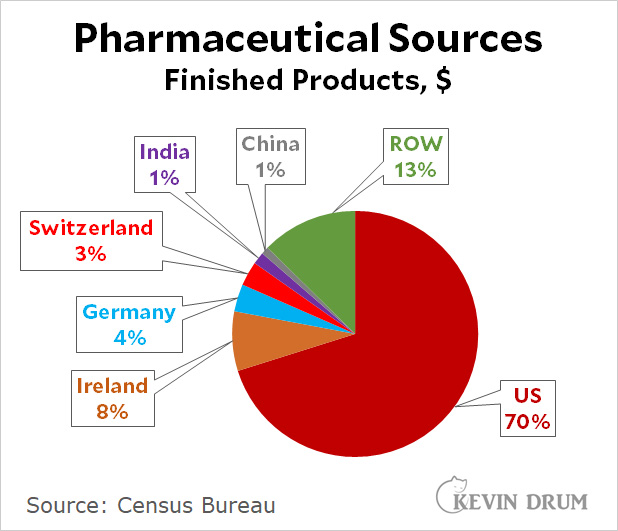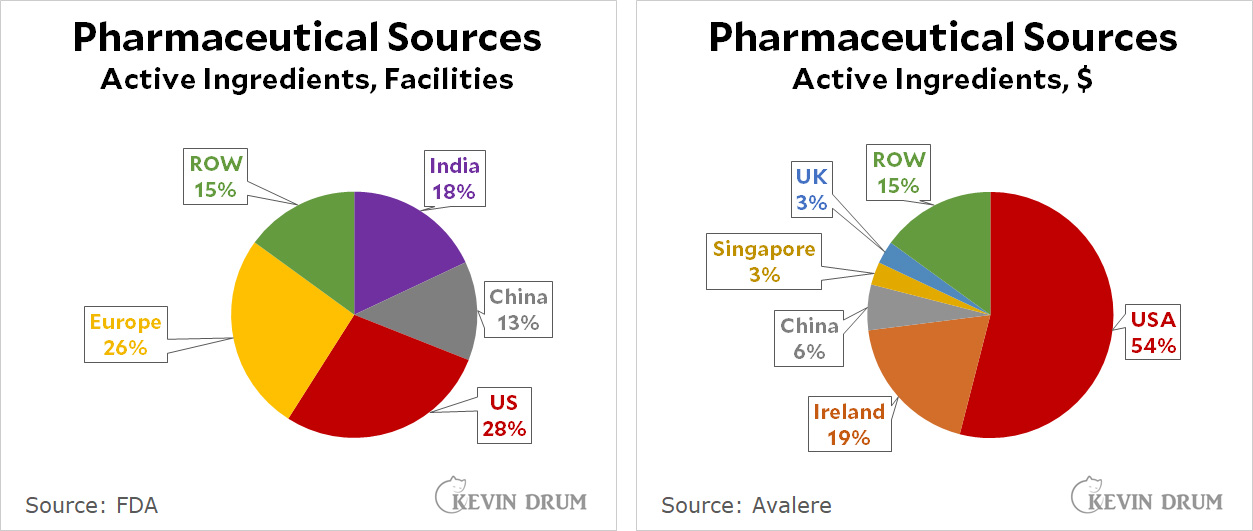Are you curious about how much of our pharmaceutical supply is sourced from China? Me neither. But I was given this as a homework assignment, so here's the answer:
 This is from 2019, when the total US market for pharmaceuticals was about $500 billion and we imported $150 billion of that. It includes everything: prescription drugs, OTC drugs, biopharmaceuticals, etc.
This is from 2019, when the total US market for pharmaceuticals was about $500 billion and we imported $150 billion of that. It includes everything: prescription drugs, OTC drugs, biopharmaceuticals, etc.
But this doesn't provide the whole picture. We get very few finished pharmaceuticals from China, but they provide a sizeable share of the Active Pharmaceutical Ingredients (API) used by other countries in the final manufacturing process:
 China has about 13% of the API facilities in the world, but they tend to make relatively high volume/low value ingredients. By dollar amount, they are responsible for only 6% of American imports.
China has about 13% of the API facilities in the world, but they tend to make relatively high volume/low value ingredients. By dollar amount, they are responsible for only 6% of American imports.
If you look only at drugs that are considered essential, the numbers are about the same. It's also worth noting that the dollar figures for Ireland are inflated for all the usual scammy tax avoidance reasons, so don't take them too seriously.

ROW?
That took me a while too.
Republic of Wherever.
Rest of World
Republic of Wakanda. They have advanced technologies, you know.
I don't understand why there is no pie slice for India on the API-$ graph.
India is particularly problematic because there is effectively no regulation of manufacturing conditions or product quality. To make matters worse, the FDA's feeble attempts to oversee foreign manufacturing facilities were completely on hold during the first years of the pandemic.
It's the cheaper commodity products that really hit people when there is a shortage, or when the market is captured by a given individual who hikes prices because they can.
Shh. The narrative is to disregard China behind the curtain…
That said, what matters more than where they (or another country) is today, dare I say it, is the trend. In which direction is each of China’s share going? Increasing? Decreasing? Literally flat?
Now do rare earth metals.
Kevin, your charts are reassuring, but I wonder about the story behind the numbers. Also, you credit your sources, Census Bureau, FDA, and Avalere, but when I go to those sites, I do not find the data, and it is not from lack of trying. I cannot navigate these sites to find the data as you do. Could you provide the actual links you are getting the data from?
Labor is not an important part of the direct production of pharmaceutical as affecting price - profits come from the price increments of patents. So at the moment there is not a big benefit to outsourcing production. The cost of patents is in research, so "labor" in that area has some importance. If China and the other countries get to the point where they can do the research, then more of drug production will be moved.
Kevin shows the fractions by value, but the result might be very different going by volume. I have not been able to find much real data, but certainly more generics are made abroad.
One problem is the lack of quality control among buyers. I gather that has tightened a bit since 2018 when NDMA, a carcinogen, was found in Valsartin, a blood pressure medication, among others. With all the feeders on the pharma value chain, only one outfit was actually testing the drugs it was repackaging under its own name.
If you follow pharma chemistry, you know that a lot of routine synthesis is outsourced to India and China. Why whip up a batch of some candidate or precursor for testing when you can just send for it? Most labs don't actually test what they get to make sure it is what they ordered in the appropriate concentration, form and solution. Again, I think there has been some tightening here with more researchers getting burned over the years.
China makes almost all of the vitamins. So anything you eat that has vitamins and minerals sprayed on it, mixed in, comes from Chinese factories. So all foods with an *enriched* component - in the US this includes all wheat products and all rice products, have Chinese inputs. All breads, pastas, rice products use enriched starches in the US so are sprayed with Chinese products. Milk, dairy, usually have vitamin D added, so those too.
Essentially all packaged foods have either enriched starches, or chemicals/preservatives that come from Chinese factories.
Chinese factories make almost the entire world supply of caffeine, which is added to all carbonated sodas - the caffeine in a Coke or Diet Pepsi doesn't come naturally from the cola beans, its synthetically produced and added to many products.
Maybe even the chemicals sprayed on the agricultural crops, fertilizers, etc., come from there, I haven't looked.
Manufacturing in China has come a long way, and might be better - cleaner, regulated - than factories in the US. Wasn't true 20 years ago, but it might be now, I have no idea.